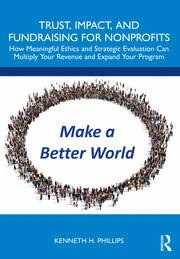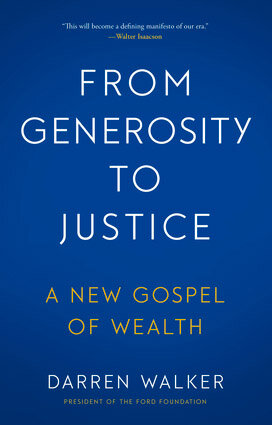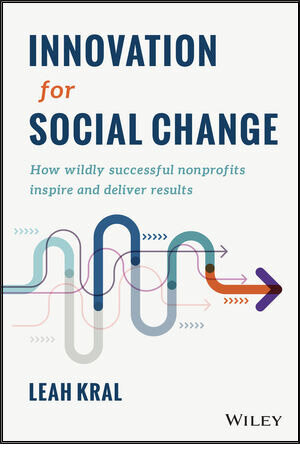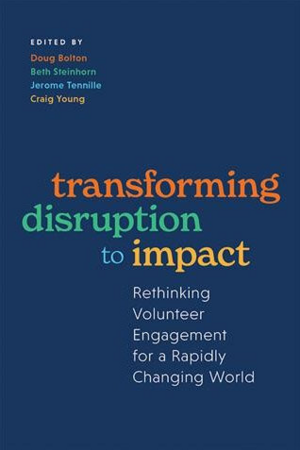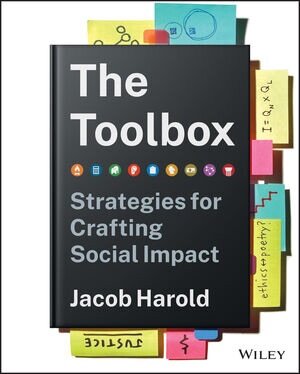Trust, Impact and Fundraising for Nonprofits: How meaningful ethics and strategic evaluation can multiply your revenue and expand your program
One question that I frequently ask in my fundraising classes is: “Why do people give?” I want the attendees to think about the myriad reasons for giving, such as “to feel good,” “to invest in the future,” “to get a tax deduction,” and (of course) “because you ask!”
Kenneth H. Phillips’s book, Trust, Impact and Fundraising for Nonprofits: How meaningful ethics and strategic evaluation can multiply your revenue and expand your program, takes a different tack, asking, in effect, “Why DON’T people give?” This book—the fourth in Phillips’s Make a Better World series, takes an analytical and practical look at the reasons behind a donor’s decision not to give. And as the title indicates, Phillips links this to two issues: the lack of trust in nonprofits and the lack of clear indications of nonprofit impact as shown through evaluation.
Phillips bases his conclusions on many well-chosen statistics—but also on his own vast experience. Phillips worked for 60 years in leadership and planning roles with national and international nonprofits, including Save the Children, Plan International, the Red Cross Movement, Catholic Relief Services, Help Age International, CARE International, and International Youth Foundation. To further communicate one of his key messages—the importance of “continuous learning, developing—and doing,” he breaks down his own experience in detail to indicate his most significant learning experiences and work; as he says, “I did it and you can too.... You will do something important and feel good about that.”
The book is well organized and easy to follow: Phillips uses graphics, charts, bulleted lists, worksheets, and summaries of preceding paragraphs into “key points” so that all of the chapters flow easily and recapitulate the main themes. Though long and thorough, the guide is easily digestible.
In the introduction, Phillips links his earlier work on strategic planning to the book’s focus on “[t]he two biggest challenges—[e]thics and evaluation.” He shares his vision of strategic planning as made up of eight components, “vision, mission, values, culture, goals, strategies, impact, and trust.” The book’s main point is summed up in this way: “Only when organizations are trusted for their good behavior and respected for their lasting impact will they receive the support they need to carry out the work they were created to do. They earn trust through ethical behavior and gain respect by achieving real results, then communicating those qualities to be accountable.”
The book’s main point is summed up in this way: “Only when organizations are trusted for their good behavior and respected for their lasting impact will they receive the support they need to carry out the work they were created to do. They earn trust through ethical behavior and gain respect by achieving real results, then communicating those qualities to be accountable.”
Before getting into solutions for operating a nonprofit in an ethical and accountable manner, Phillips uses the first half of “Part I: Meaningful ethics for trust” to do a survey of the latest research on giving, citing research by the Urban Institute on how funding in the charitable sector is large but declining, particularly among low- and middle-income donors. Phillips couples those statistics with research by Giving USA and the Indiana University Lilly School of Philanthropy, quoting the latter: “The share of American households that donate to charity has been steadily declining since the Great Recession [of 2007-2009].”
But why are they not giving? Phillips introduces and dismisses several hypotheses that could answer that question, including:
- “People don’t have enough money” (“When measured in constant 2012 dollars to adjust for inflation, [United States’ per capita personal income] advanced 297.1% from $13,971 in 1959 to $55,477 in 2021,” according to the United States Regional Analysis Project
- “The needs are already being met” (As the United Nations’ Sustainable Development Goals point out, there are “huge needs yet to be met and an opportunity for everyone to step up.”
- “Tax benefits don’t provide enough incentive for donations” (Tax rates have decreased steadily since the 1950s, and “the tax benefit for mega-donors in the United States is huge.”)
- “Charity and generosity have decreased these days—people just don’t care” (“Even though issues like racism, violence, and abuse are pervasive, they are now receiving more attention. More people are caring….When people…feel connected and understand how they can help, their charity and their generosity will rise to the surface.”
In Phillips’s analysis, the real cause for not giving is: “Nonprofits don’t have enough trust, impact, or non-fundraising communication.” Phillips quotes studies by Princeton Survey Research Associates (“15% of those surveyed said they had a great deal of confidence in charities…but 35% said they had little or no confidence in charities”), Independent Sector (“Trust is a necessary condition for public engagement with nonprofit organizations,” and the Edelman Trust Barometer (“Information quality [is the]most powerful trust builder across institutions.” Nonprofits that communicate more about all they do for beneficiaries and for society—without always fundraising at the same time—will be more effective and will therefore receive more donations. “The first of my Iron Rules of Fundraising is that ‘Fundraising is not about money.’ It’s about who you are, what you do and why I should trust you.”
The remainder of Part I discusses how to implement meaningful ethical behavior in a nonprofit—“meaningful” being the key word. Creating the code of ethics is only the first step; codes of ethics should be “operationalized”—explicit in what is expected and what is not tolerated within an organization. They should be regularly assessed, have clear procedures for dealing with complaints, delineate ways for experts to verify the claims, have clear procedures for sanctions for non-compliance, and incorporate clear communication to all constituents. Key to this is a commitment by the whole organization (Phillips recommends the appointment of a “Chief Trust Officer”) and a role for every employee to step up and contribute to the development of a code of ethics. He offers case studies of differently sized organizations to show a participatory process for the creation of a code; three studies of how codes of ethics can be made stronger with external verification; and a large-scale, statewide effort that relied on strong enforcement for its effectiveness.
He characterizes strategic evaluation as incorporating mentoring rather than monitoring so that, rather than simply judge the effectiveness of a program during its implementation, the supervisor guides staff to make changes and improve the program.
Part II focuses on evaluation—strategic evaluation, as Phillips characterizes it. This is differentiated from the type of “tactical” evaluation a nonprofit does simply to fulfill the wishes of a grantmaker. In analyzing the differences, Phillips calls on nonprofits to move from a focus on monitoring and evaluation—simply collecting data for reporting purposes—to a model that “turns evaluation back into learning messages, creates channels of feedback within an organization, and allows evaluation findings to flow upward within an organization.” He characterizes strategic evaluation as incorporating mentoring rather than monitoring so that, rather than simply judge the effectiveness of a program during its implementation, the supervisor guides staff to make changes and improve the program. In this model, monitoring becomes mentoring, and evaluation becomes learning. “Strategic evaluation uses monitoring/mentoring to make short-term corrections, uses evaluation for learning to build its capacity to do better, and improves results in the future. This impresses donors more than a tactical report.”
As illustration, Phillips leads readers through eight disciplines necessary for implementing strategic evaluation: board responsibility, management responsibility, a culture of learning, mentoring, evaluation of program strategy, evaluation of results, organizational self-assessment, and mutual accountability with your partners. This may seem daunting, but he breaks down each discipline into workable action steps and offers eleven case studies of differently sized organizations and how they were able to implement strategic evaluation.
One small criticism of these useful case studies is that many organizations choose acronyms of their own to describe very similar evaluation processes, so that it is sometime difficult to clarify what MERL, MEAL, and REL (among many others) refer to. Another, more substantial criticism is that many of the examples of thorough evaluation come from larger organizations, and limited information is given for smaller organizations to implement effective monitoring and evaluation, other than partnering with a group of nonprofits. But the varied case studies, clear summary of steps, and excellent worksheets make this guide very practical for nonprofits serious about earning trust and communicating trustworthiness.
A final note on the author: His message (recapitulated again and again) is that anyone can—and should—work within their organizations to improve their accountability and ethical responsibility. The biographical data and amusing details he shares along the way (including drawings by his younger family members illustrating key points) humanize the process and enhance readability. Phillips’s book is recommended for those intimidated by the strategic evaluation process who need a gentle (but thorough!) introduction.
David M. Holmes is a network engagement manager at Candid.


